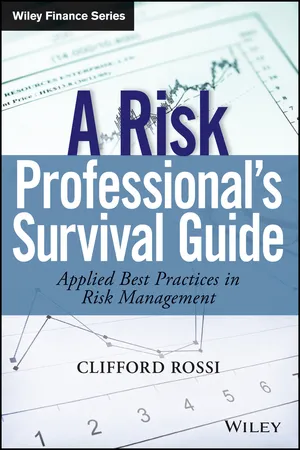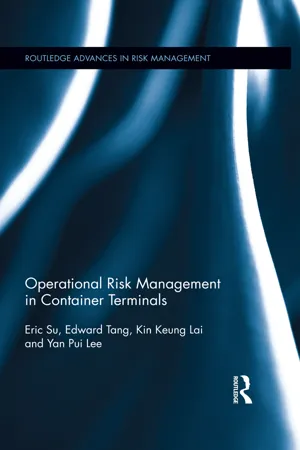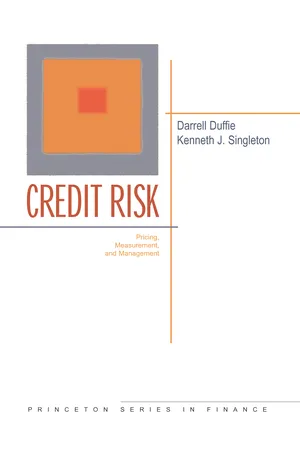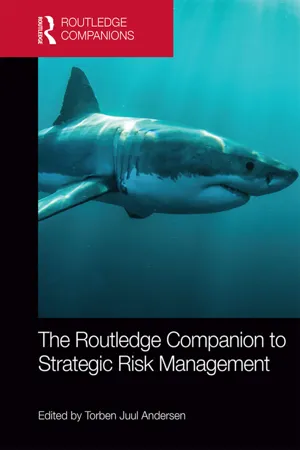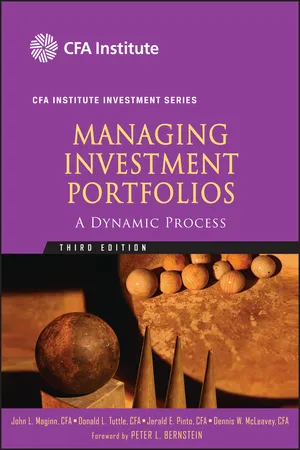Economics
Risk Management Techniques
Risk management techniques in economics involve strategies and tools used to identify, assess, and mitigate potential risks that could impact financial investments or business operations. These techniques may include diversification, hedging, insurance, and risk transfer. By employing these techniques, individuals and organizations can better protect themselves from adverse events and make more informed decisions regarding their financial activities.
Written by Perlego with AI-assistance
Related key terms
9 Key excerpts on "Risk Management Techniques"
- eBook - ePub
- Tony Merna, Faisal F. Al-Thani(Authors)
- 2011(Publication Date)
- Wiley(Publisher)
4 Risk Management Tools and Techniques4.1 INTRODUCTION
The management of risk is currently one of the main areas of interest for researchers and practitioners working in a wide range of projects because of the benefits of the process. Risk management is one of the key project management processes. Numerous techniques are available to support the various levels of the risk management process.Risk management is a tool which is increasingly used in organisations and by public bodies to increase safety and reliability and to minimise losses. It involves the identification, evaluation and control of risks. Implicit in the process is the need for sound decision making on the nature of the potential socio-technical systems and their predicted reliability. The need for safety measures and guidance as to where they should be displayed are, in theory, the natural products of combined probabilistic risk assessment/human reliability analysis (PRA/HRA) studies. In an ideal world, good assessment should always drive effective error reduction.This chapter describes the tools and techniques used in the assessment of risk, both qualitative and quantitative, and country risks which are often considered a major factor in risk assessment. The tools and techniques described can be used at corporate, strategic business and project levels.4.2 DEFINITIONS
French and Saward (1983) describe a tool as any device or instrument, either manual or mechanical, which is used to perform work. Distinguishing between a tool and technique is difficult. For the purpose of this book the present authors define tools as:The methodology which employs numerous techniques to achieve its aim .For example, risk management (tool) employs numerous techniques such as sensitivity analysis, probability analysis and decision trees. Value management (tool) employs such techniques as functional analysis, optioneering and criteria weighting. - eBook - ePub
A Risk Professional�s Survival Guide
Applied Best Practices in Risk Management
- Clifford Rossi(Author)
- 2014(Publication Date)
- Wiley(Publisher)
CHAPTER 2 Overview of Financial Risk ManagementRISK MANAGEMENT DEFINED
Risk management describes a collection of activities to identify, measure, and ultimately manage a set of risks. People and organizations confront risks every day: For example, an individual decides to leave a relatively secure job for another with better opportunity and compensation across country, a government faces the threat of terrorist attacks on public transportation, or a bank determines which financial products it should offer to customers. While some risks are fairly mundane and others a matter of life or death at times, the fundamental process for assessing risk entails evaluation of trade-offs of outcomes depending on the course of action taken. The complexity of the risk assessment is a function of the potential impact from a particular set of outcomes; the individual deciding to take a different job is likely to engage in a simpler risk assessment, perhaps drawing up a pros and cons template, while a government facing terrorist threats might establish a rigorous set of quantitative and surveillance tools to gather intelligence and assign likelihoods and possible effects to a range of outcomes.Regardless of the application or circumstance, each of the assessments above has a common thread, namely, the assessment of risk. But what exactly is risk and is it the same across all of these situations? Risk is fundamentally about quantifying the unknown. Uncertainty by its very nature tends to complicate our thinking about risk because we cannot touch or see it although it is all around us. As human beings have advanced in their application of technology and science to problem solving, a natural evolution to assessing risk using such capabilities has taken place over time. Quantifying uncertainty has taken the discipline of institutional risk management to a new level over the past few decades with the acceleration in computing hardware and software and analytical techniques. - Eric Su, Edward Tang, Kin Keung Lai, Yan Pui Lee(Authors)
- 2015(Publication Date)
- Routledge(Publisher)
Risk management concept and theory5.1 Risk managementRisk management has been a hot topic in academic fields in the last few decades, especially after the occurrence of catastrophic accidents and major financial crises, such as the Chernobyl nuclear power plant disaster in 1986 and the dot-com bubble in 1997 to 2000. In reality, similar risks have repeatedly occurred even though the causes and the extent of damage may not be exactly the same. During the last 5 years, we have encountered the financial tsunami in 2008 and the accident in Fukushima I Nuclear Power Plant in 2011. Risk management, as a result, is one of the key issues that most entities today are dealing with in their daily operations.(a) Why risk management?
Risk management, as can be interpreted from the words directly, is the way of handling uncertainties that may lead to detrimental consequences. Interestingly, Hubbard (2009) uses a simple phrase to describe the purpose of risk management, which is “being smart about taking chances” (p. 10). On the other hand, Paté-Cornell (2012) has defined risk management as “involves by definition decisions under uncertainty that can be addressed by decision analysis” (p. 1828).Sung (2005) defines risk management as an integration of limited resources to lower deleterious effects. Here, the resource factor is taken into consideration in risk management. This is the result of the fact that we will not have an infinite amount of resources in terms of people, money, time and the like, and, sensibly, we will not reduce the risk to our acceptance level at any cost . To strike a balance is the most important element, and also the art, in risk management.Haimes and colleagues (2002) define risk management as part of the eight-phase methodology for managing risk that involves “identification of management options for dealing with the filtered scenarios, and estimating the cost, performance benefits, and risk reduction of each” (p. 383). The definition provided by Haimes and colleagues suits their developed eight-phase methodology, but in general this may confuse the readers who believe that risk management represents the whole management process rather than one step/phase of it.- Allan Ashworth, Catherine Higgs(Authors)
- 2023(Publication Date)
- Wiley-Blackwell(Publisher)
8 Risk ManagementKEY CONCEPTS
- Risk and cost management
- Risk management
- Risk identification
- Risk analysis
- Risk evaluation
- Risk plan
- Risk monitoring and reporting
- Risk management workshops
- Risk Management Techniques
LEARNING OUTCOMES
After reading this chapter, you should be able to:- Understand how quantity surveyors allow for risks in cost planning.
- Discuss the application of risk management to identify, analysis, evaluate and manage risks during the design and construction process.
- Appreciate the range of Risk Management Techniques, both qualitative and quantitative, and their appropriate use.
COMPETENCIES
Competencies covered in this chapter:- Design economics and cost planning
- Project feasibility analysis
- Project finance (control and reporting)
- Risk management
Introduction
Risk management is a practice that many of us use instinctively at a personal level on a regular basis; however, the importance of active risk management in construction demands greater attention. The complexity and scale of most building projects is such that good risk management in the construction industry requires more than purely common sense and instinct.‘A risk can be defined as an uncertain event or circumstance, that if it occurs, will affect the outcome of a project’ (RICS 2015 ). In resolving uncertainty a better outcome may be achieved, for example a cost saving; therefore, risks must be considered as having both positive and negative outcomes.Construction projects are full of risks and include those that relate to external commercial factors, design, construction and operational matters. Risk management provides the opportunity to control the occurrence and impact of risk factors and provides the project team and clients with better information upon which to make decisions.The risk management principles outlined in this chapter can, in the main, be transferred to any stage of a project’s development. It is likely that the project manager will provide the core service of preparing the risk management strategy and maintain the project risk register; however, as part of the team, the quantity surveyor will make a valuable contribution to risk mitigation.- eBook - ePub
Quality in the Era of Industry 4.0
Integrating Tradition and Innovation in the Age of Data and AI
- Kai Yang(Author)
- 2023(Publication Date)
- Wiley(Publisher)
Risk management signifies a proactive, systematic procedure for the identification, evaluation, prioritization, and mitigation of risks that aims to accomplish organizational objectives and augment decision‐making. It entails the acknowledgment of potential uncertainties, both positive and negative, while strategizing actions to curtail threats and exploit opportunities. In the current intricate and interconnected world, risk management has evolved into a crucial discipline spanning across industries and sectors.The fundamental objective of risk management is to facilitate organizations to proficiently navigate through uncertainties and safeguard their interests. It necessitates understanding the nature and extent of risks that an organization may encounter, whether originating from internal factors, external factors, or a combination of both. By comprehensively identifying risks, organizations can cultivate a holistic understanding of the potential impact and the probability of occurrence, thus enabling them to allocate resources and devise suitable risk mitigation strategies.Risk management encapsulates a series of activities and processes collaboratively working to address risks. These comprise risk assessment, which involves evaluating the significance and potential repercussions of identified risks, and risk analysis, which delves into examining the root causes and contributing factors of the risks. Additionally, risk management includes the selection and execution of risk response strategies, such as risk transfer, risk avoidance, risk reduction, or acceptance, contingent on the organization's risk appetite and capacity.A robust risk management framework offers a structured and consistent method for managing risks across an organization. It delineates clear roles, responsibilities, and processes for identifying, evaluating, and responding to risks. Risk management frameworks also contemplate the context in which an organization operates, considering factors such as legal and regulatory requirements, industry standards, and stakeholder expectations.Organizational culture assumes a pivotal role in risk management. A risk‐aware culture promotes open communication, transparency, and accountability concerning risks. It encourages a proactive mindset, where individuals across all organizational levels actively partake in risk identification and mitigation. Leadership bears an integral role in advocating and integrating risk management practices, setting the tone for risk awareness and accountability throughout the organization. - eBook - ePub
Credit Risk
Pricing, Measurement, and Management
- Darrell Duffie, Kenneth J. Singleton(Authors)
- 2012(Publication Date)
- Princeton University Press(Publisher)
2
Economic Principles of Risk Management
WHY DO MANAGERS of financial institutions care about financial risks? Are the economic incentives for managing market and credit risks the same, or does credit risk present different challenges, calling for distinct measurement systems or tools? These are some of the questions that we begin to address in this chapter. The economics of risk management for financial firms is far from an exact science. While rigorous and empirically testable models can be brought to the task of measuring financial risks, some of the benefits and costs of bearing these risks are difficult to quantify.In a hypothetical world of perfect capital markets—as we know from the work of Modigliani and Miller (1958), widely held to be the basis for the Nobel prizes awarded to Franco Modigliani and Merton Miller—any purely financial transaction by a publicly traded firm has no impact on that firm’s total market value. Capital markets, however, are not perfect. Market imperfections underlie significant benefits for banks and other financial institutions for bearing and controlling financial risks. Indeed, we name and characterize many of these benefits. One should not, however, anticipate a model allowing a practical cost-benefit analysis of risk that leads to precise quantitative trade-offs. Some of the important channels through which risk operates to the detriment or benefit of a financial corporation are not readily priced in the market.For instance, there are no obvious formulas to determine the market value that can be created by a financial firm willing to bear a given amount of risk through proprietary trading or intermediation. In perfect capital markets, after all, securities are priced at their fair market values, and trading could therefore neither add nor subtract market value. Any such formula relating financial risk bearing to the market value of the firm would, in the reality of imperfect capital markets, depend on such difficult-to-capture variables as the human abilities of traders and management, the information flows available to the firm, its reputation, its access to customers, and its organization of the risk-management function itself, not to mention a host of economic variables that characterize its economic environment. - eBook - ePub
- Rick Nason, Brendan Chard(Authors)
- 2018(Publication Date)
- Business Expert Press(Publisher)
CHAPTER 2 Financial Risk Management Tools and Tactics Responses to RiskBefore beginning a discussion of the various tools and tactics used to manage financial risks, it is instructive to review the range of possible responses to financial risks. It is appropriate to realize that there is a range of responses to risk: eliminate, avoid, mitigate, ignore, embellish, and embrace.1 These responses range from weak (mitigate, embellish) to neutral (ignore), to strong (eliminate, embrace), and also reflect the philosophy that risk can be positive as well as negative. Just as the responses to risk have a range, so too do the financial risk management tools. Furthermore, just as it is important in any type of craftsmanship to choose the right tool for the task, so it is in financial risk management.Part of choosing the tool for risk management depends on whether the risk is predominately a negative risk, or predominantly a positive risk. Not always, but generally in financial risk management, a risk that is a negative risk for one organization is a positive risk for a different organization. A second component is understanding the side effects, or the unintended consequences of a risk tool. An old saying about financial risk management is that the “only perfect hedge is in a Japanese Garden.” Virtually all risk tools either have an explicit cost or some unintended consequence that renders the risk tool as less than perfect. That is simply the nature of risk management. That is not to say that one should not use risk management tools, but one does need to know the respective advantages and drawbacks of the various tools available to the risk manager.Operational Financial Risk Management StrategiesThere are several operational strategies for managing financial risk. For instance, operations can be designed to offset currency risks; financing can be arranged to minimize interest rate risk; sales contracts can be set to reduce commodity price risk. The way an organization chooses to implement its operations can provide a wide variety of risk benefits. - Torben Andersen(Author)
- 2015(Publication Date)
- Routledge(Publisher)
Harrison and Phillips (2014 : p. 164): “it was apparent from the serious economic journalism of 2006, 2007 and early 2008 that there were many ‘canaries in the cave’ that anticipated the landscape of the financial crisis of 2008.” In other words, there is a tendency to ignore even the most obvious signs of emergent risk events. With a bit of luck, this is what risk management practices might be able to circumvent by creating more risk conscious organizational settings.Strategic risk management is a conceptual extension of risk management indicating that risk management somehow has become strategic. Using the term strategic may simply indicate that the derived concept is considered important with the aim of giving it a more imposing flair (Andersen, 2013 ). Risk management is typically conceived as the structured process of identifying and dealing with risks followed by monitoring and controls to minimize the negative downside effects of risk events and to maximize the positive upside potential of opportunities in line with corporate objectives.1 Hence, according to the Institute of Risk Management (IRM), risk is the probability of an event and its consequences that can have both positive and negative outcomes. It is argued that anything that may obstruct, or create uncertainty about the ability to achieve organizational objectives at the strategic, tactical and operational levels constitutes a risk. COSO (2004) 2 describes enterprise risk management (ERM) as a process initiated by the board of directors involving management and personnel across the enterprise to identify potential risk events and manage them within a given risk appetite to ensure that organizational objectives can be achieved. These views establish a potential link between the risk management process and the ability to achieve intended outcomes that are considered to be of strategic importance. A recent practice-based view (PBV) of strategy scholarship (Bromiley and Rau, 2014- eBook - ePub
Managing Investment Portfolios
A Dynamic Process
- John L. Maginn, Donald L. Tuttle, Dennis W. McLeavey, Jerald E. Pinto, John L. Maginn, Donald L. Tuttle, Jerald E. Pinto, Dennis W. McLeavey(Authors)
- 2010(Publication Date)
- Wiley(Publisher)
Companies that succeed in doing the activities they should be able to do well, however, cannot afford to fail overall because of activities in which they have no expertise. Accordingly, many companies hedge risks that arise from areas in which they have no expertise or comparative advantage. In areas in which they do have an edge (i.e., their primary line of business), they tend to hedge only tactically. They hedge when they think they have sufficient information to suggest that a lower risk position is appropriate. They manage risk, increasing it when they perceive a competitive advantage and decreasing it when they perceive a competitive disadvantage. In essence, they attempt to efficiently allocate risk. Similarly, portfolio managers attempt to efficiently use risk to achieve their return objectives.We have illustrated that risk management involves far more than risk reduction or hedging (one particular risk-reduction method). Risk management is a general practice that involves risk modification (e.g., risk reduction or risk expansion) as deemed necessary and appropriate by the custodians of capital and its beneficial owners.For the risk management process to work, managers need to specify thoughtfully the business processes they use to put risk management into practice. We refer to these processes collectively as risk governance, the subject of the next section.3. RISK GOVERNANCE
Senior management is ultimately responsible for every activity within an organization. Their involvement is thus essential for risk management to succeed. The process of setting overall policies and standards in risk management is called risk governance. Risk governance involves choices of governance structure, infrastructure, reporting, and methodology. The quality of risk governance can be judged by its transparency, accountability, effectiveness (achieving objectives), and efficiency (economy in the use of resources to achieve objectives).Risk governance begins with choices concerning governance structure. Organizations must determine whether they wish their risk management efforts to be centralized or decentralized. Under a centralized risk management system, a company has a single risk management group that monitors and ultimately controls all of the organization’s risk-taking activities. By contrast, a decentralized system places risk management responsibility on individual business unit managers. In a decentralized approach, each unit calculates and reports its exposures independently. Decentralization has the advantage of allowing the people closer to the actual risk taking to more directly manage it. Centralization permits economies of scale and allows a company to recognize the offsetting nature of distinct exposures that an enterprise might assume in its day-to-day operations. For example, suppose one subsidiary of a company buys from Japan and another subsidiary sells to Japan, with both engaged in yen-denominated transactions. Each subsidiary would perceive some foreign exchange exposure. From a centralized viewpoint, however, these risks have offsetting effects, thereby reducing the overall need to hedge.
Index pages curate the most relevant extracts from our library of academic textbooks. They’ve been created using an in-house natural language model (NLM), each adding context and meaning to key research topics.

